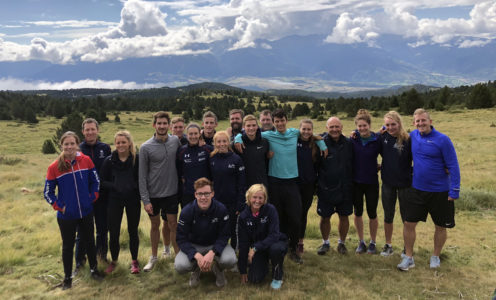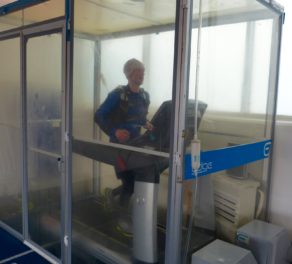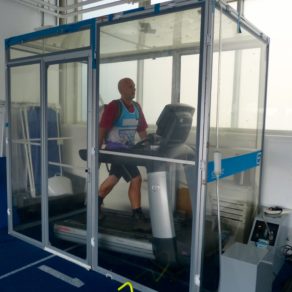50 days to Tokyo: how high-altitude training is helping athletes prepare to reach new heights on Olympic and Paralympic stage

With the Tokyo Olympic Games now just 50 days away, many sports – including the prolific medal-winning GB modern pentathlon team based at the University of Bath – will be planning or have considered high altitude or hypoxic training as part of their preparation.
Why? And does it work for all types of sport and everyone?
Pentathlon GB Performance Director Jan Bartu, is an advocate and says: “Pentathlon GB Performance has been training at altitude on an annual basis since 2001 (2018 training camp in Font Romeu pictured top). Positive training effects on fitness, aerobic cardiovascular function, general strength and, most importantly, wellbeing have been the main reasons for training in altitude.
“It requires careful management of training load, individual athlete acclimatisation strategies and scientific feedback on athlete response to make this programme successful. Although training in altitude can be a challenge, it brings great results if implemented with knowledge and experience.”
High-level science behind altitude training
Team Bath Applied Sport Scientist Jonathan Robinson, who is an accredited physiologist, says that the science in this area is interesting, high-level, copious and often nuanced depending on the individual.
He has been involved either directly or indirectly in altitude preparation for Bath-based individuals or sports like skeleton – who used it first for athletes headed to Park City, the 2002 Salt Lake Games high-altitude track – and swimming, who tailor preparation on a very individual level, as well as rowing whose GB Rowing Team men’s squad have successfully used altitude training at their annual Silvretta and Sierra Nevada training camps.
Robinson also offers individual or group altitude training options at the Team Bath Sports Training Village within a specialised ‘hypoxic’ or altitude-simulating environment. This is particularly relevant to anyone doing a charity climb or event at altitude.
The whole, adopted premise of altitude training is to get the body to react to more limited oxygen levels in the atmosphere at altitude to produce a higher red cell count. On return to sea level, after an average of 10 days to two weeks, this could mean that an individual can take up more oxygen whilst exercising and potentially perform better when competing.
The effects are said to be valid for endurance sports and events as well as the more explosive sports but is the science uniformly in favour?

Live high, train low
Robinson explains: “Some individuals react well to hypoxic training but others may find that their performance decreases and that’s why the balance of the benefits of altitude need to be weighed up against the negatives of not being able to train as hard. Altitude can be achieved geographically or in a simulated environment through the use of altitude chambers, tents and even hotels.
“More recently some sports have turned to the process of ‘live high but train low’ – i.e. coming down to a lower altitude to train, as athletes can’t train at the same intensity and speed at altitude and might therefore lose muscularity, whilst gaining the hypoxic effect of sleeping and daily living at altitude. It’s why you now hear about sports using altitude chambers, tents and hotels even in the UK.”
The four main reasons
“Sports and individuals generally use hypoxic training for four purposes – acclimatisation, to improve performance on return to lower or sea levels, for injury rehabilitation, for better general health,” says Robinson.

Acclimatisation
Just like skeleton in 2002, it’s about getting used to performing at altitude if the major event itself is at high altitude. The British Lions, just about to return to South Africa now, used this previously for a tour there.
“The statistics for the Mexico City Olympic Games in 1968 are still amongst the most revealing,” says Robinson. Mexico City is at an altitude of 2,240m and, in the thinner air, witnessed the first sub-10 second 100m and world records in the long and triple jump but also produced very slow winning times in the marathon and 1,500m swim, for instance.
However, the science shows that athletes can perform well at altitude if they either compete within 24 hours of arrival or acclimatise for a minimum of three weeks before their event, gradually building intensity of training from 60-100% over the first 10-14 days.
Improved performance on return to sea level
Here the science is more uncertain, according to Robinson. He suggests that the performance benefits of ‘living high and training high’ even 10-14 days after return to near sea level are unproven generally but are still used effectively by many sports if individually tailored. Yet ‘live high, train low’ does offer enhanced performance at sea level because it avoids the pitfalls of lowering of maximal heart rate, loss of muscle mass etc.
The main physiological benefits are increased red blood cells, plasma volume and haemoglobin mass, and ultimately increased oxygen carrying capabilities which will be most beneficial for endurance sports.
Rehabilitation
It’s been proven that intermittent, simulated hypoxic training can help athletes rehabilitate from injury more successfully. This type of training is used to avoid loss of fitness – the athlete has to work harder with less physical effort which helps speed up recovery and reduces downtime.
Better general health
According to Robinson, this is a grey area and very much up to the individual and sits outside the pure sports remit.
Conclusion
Many serious amateur triathletes and endurance sports enthusiasts have tried simulated or geographical altitude training – some supported by Team Bath. Robinson says the best way, though, is to test something before you use it ‘for real before an event’ and to read up on the science and tailor what you do to your individual rather than group needs.
Want to work on your altitude training in the hypoxic chamber at the Team Bath Sports Training Village? Or generally test your levels of fitness and maximise your training? Our Sports Science team are here to help. Click here for more information.




